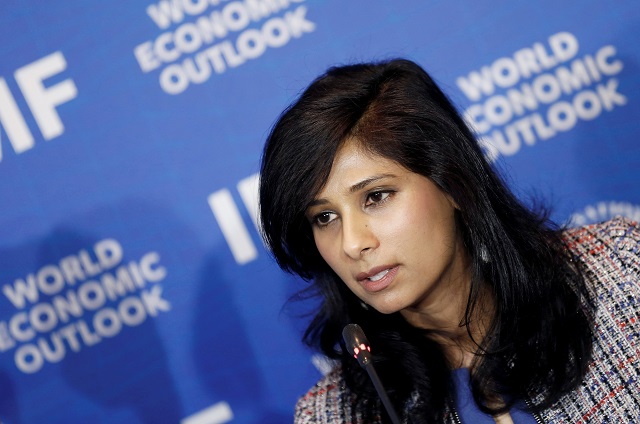
Washington, U.S. | Xinhua | The International Monetary Fund (IMF) on Tuesday projected the global economy to grow by 4.4 percent in 2022, down by 0.5 percentage point from October’s forecast, according to a newly released update to its World Economic Outlook report.
Growth will slow as economies grapple with supply disruptions, higher inflation, record debt and persistent uncertainty, First Deputy Managing Director Gita Gopinath told a virtual press briefing.
“The rapid spread of the Omicron variant has led to renewed mobility restrictions in many countries and increased labor shortages,” said Gopinath, who was previously the IMF’s chief economist.
She added that while Omicron will weigh on activity in the first quarter of 2022, this effect will fade starting in the second quarter.
Petya Koeva Brooks, deputy director of the IMF’s Research Department, told Xinhua in a remote interview Tuesday that the IMF assumption is while there may be localized lockdowns and “things kind of flaring up,” the level of hospitalizations and the number of deaths are going to be at much lower levels by the end of the year.
“Which is another way of saying that we’re essentially moving to a situation where in one shape and form, we are living with the virus,” Brooks said. “So when it comes to the economic impact .. we expect that effect to not be as pronounced in the latter part of this year.”
Brooks, however, noted that there are downside risks to the IMF’s assumption regarding the pandemic. “So we cannot preclude the possibility of a new variant and then that having an implication for economic activity.”
Supply disruptions still weigh on activity and are contributing to higher inflation, Gopinath noted. Supply-demand imbalances are assumed to decline over 2022 based on industry expectations of improved supply, as demand gradually rebalances from goods to services, and extraordinary policy support is withdrawn.
The IMF has revised up 2022 inflation forecasts for both advanced and emerging market and developing economies, with elevated price pressures expected to persist for longer. Assuming inflation expectations remain anchored, inflation is expected to subside in 2023.
Noting that major central banks, including the U.S. Federal Reserve, is going to “exit highly accommodated monetary policies,” Gopinath told reporters that interest rates are expected to go up.
Many economists have said the U.S. Fed will likely use this week’s policy meeting to pave the way for raising interest rates in March for the first time since the onset of the COVID-19 pandemic, making a hawkish pivot to combat surging inflation.
“There is a tremendous amount of uncertainty, about how much would it go up by and how many rate hikes it would take,” Gopinath said, adding that “we would see corrections in markets.”
She said the hope is that this will stay “orderly,” calling for well telegraphed communication from the U.S. Fed about its monetary policy path, about the reasons for taking the actions.
With interest rates rising, low-income countries, of which 60 percent are already in or at high risk of debt distress, will find it increasingly difficult to service their debts, Gopinath warned, calling for a revamp of Group of Twenty (G20) Common Framework to deliver more quickly on debt restructuring, and suspension of debt service while the restructurings are being negotiated.
According to the latest report, global trade will moderate in 2022 and 2023, in line with the overall pace of the expansion, and cross-border services trade – particularly tourism – is expected to remain subdued.
The IMF projects that global trade is on track to grow by 6.0 percent this year, down by 0.7 percentage point from October’s forecast. Global trade will expand by 4.9 percent next year, the projection showed.
Noting that trade is one of the areas where recovery was “very strong” after the collapse in 2020, Gopinath said in response to a question from Xinhua that global demand has shifted more toward goods away from services since the pandemic, which also helped trigger a lot of trade.
“I think looking forward, we should keep in mind that as things normalize and as demand starts pivoting back to services away from goods … we should expect to see some slowing in the growth in trade,” she said at the virtual press conference.
According to the IMF’s latest projection, advanced economies are expected to grow by 3.9 percent in 2022, down by 0.6 percentage point from October’s forecast, while emerging market and developing economies are on track to grow by 4.8 percent, down by 0.3 percentage point from previous forecast.
The U.S. economy will grow by 4.0 percent this year, and the euro zone economy is expected to expand by 3.9 percent. The Chinese economy will see a growth rate of 4.8 percent in 2022, and 5.2 percent next year.
The IMF expects global growth to slow to 3.8 percent in 2023. This is 0.2 percentage point higher than in the World Economic Outlook last October and largely reflects a pickup after current drags on growth dissipate, according to the latest report.
The IMF has repeatedly stressed the divergence in prospects across countries. “While advanced economies are projected to return to pre-pandemic trend this year, several emerging markets and developing economies are projected to have sizable output losses into the medium-term,” Gopinath noted.
As of now, only 4 percent of the populations of low-income countries are fully vaccinated versus 70 percent in high-income countries, according to the multilateral lender.
There is an “urgent” need to close the 23.4-billion-U.S.-dollar financing gap for the Access to COVID-19 Tools Accelerator, a global platform led by the World Health Organization, and to incentivize technological transfers to help speed up the diversification of global production of critical medical tools, especially in Africa, Gopinath said.
At the national level, she said, policies should remain tailored to country-specific circumstances including the extent of recovery, underlying inflationary pressures and available policy space.
Gopinath noted that much work remains to ensure the losses are contained and to reduce wide disparities in recovery prospects across countries. Policy initiatives, she said, are needed to reverse the large learning losses suffered by children, especially in developing countries.
“I think one of the legacies that we are worried about and we are trying to talk more about … is to think about the educational losses that had been incurred as a result of this crisis,” Brooks told Xinhua.
She said the effects are “much more pronounced” and the potential repercussions are “much worse” for many low-income emerging markets where it’s not easy to have remote learning.
“So the human capital aspect of this is something that I think we’ll need to put in a lot of effort to reverse over the coming years,” Brooks said.
On climate, a “bigger push” is needed to get to net-zero carbon emissions by 2050, with carbon pricing mechanisms, green infrastructure investment, research subsidies, and financing initiatives, Gopinath noted.
“Policymakers must vigilantly monitor a broad swath of incoming economic data, prepare for contingencies, and be ready to communicate and execute policy changes at short notice,” she said. “In parallel, bold, and effective international cooperation should ensure that this is the year the world escapes the grip of the pandemic.”
*****
Xinhua
 The Independent Uganda: You get the Truth we Pay the Price
The Independent Uganda: You get the Truth we Pay the Price



